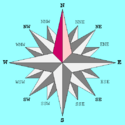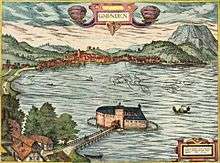Gmunden
Gmunden ([ˈɡmʊndən] (![]()
Gmunden | |
|---|---|
Lakeside | |
 Coat of arms | |
 Gmunden Location within Austria | |
| Coordinates: 47°55′05″N 13°47′58″E | |
| Country | Austria |
| State | Upper Austria |
| District | Gmunden |
| Government | |
| • Mayor | Stefan Krapf (ÖVP) |
| Area | |
| • Total | 63.52 km2 (24.53 sq mi) |
| Elevation | 425 m (1,394 ft) |
| Population (2018-01-01)[2] | |
| • Total | 13,191 |
| • Density | 210/km2 (540/sq mi) |
| Time zone | UTC+1 (CET) |
| • Summer (DST) | UTC+2 (CEST) |
| Postal code | 4810 |
| Area code | 07612 |
| Vehicle registration | GM |
| Website | www.gmunden.ooe.gv.at |
Geography
Gmunden covers an area of 63.49 square kilometres (24.51 sq mi) and has a median elevation of 425 metres (1,394 ft). It is situated next to the lake Traunsee on the Traun River and is surrounded by high mountains, including the Traunstein (mountain) (5,446 feet or 1,660 metres), the Erlakogel (5150 ft), the Wilder Kogel (6,860 feet or 2,090 metres) and the Höllengebirge.
Municipal arrangement
Gmunden is divided into the following boroughs: Gmunden, Gmunden-Ort, Schlagen, Traundorf, Unterm Stein.
Neighboring municipalities
| Ohlsdorf | Gschwandt | ||
| Pinsdorf |  |
Sankt Konrad | |
| Altmünster | Ebensee |
Population
As of 2001, Gmunden had a population of 13,336. Of that, 88.4% were Austrian in nationality, 1.5% are from other European Union states, and 10.2% are other foreigners. Citizens of Bosnia-Herzegovina (3.6%) and the former Federal Republic of Yugoslavia (2.7%) placed the strongest foreigner portion, followed by Turks (1.2%) and Germans (1.1%).
The majority (69.3%) confess themselves to the Roman Catholic Church. Evangelicals are next, which 7.3% of the population associate with. 5.9% are Muslims and 3.3% are Orthodox. 10.3% are nonreligious.
| Gmunden's population | |||||
|---|---|---|---|---|---|
| Year | Population | Year | Population | ||
| 1869 | 6.857 | 1951 | 12.894 | ||
| 1880 | 6.857 | 1961 | 12.518 | ||
| 1890 | 7.521 | 1971 | 12.331 | ||
| 1900 | 8.451 | 1981 | 12.653 | ||
| 1910 | 8.451 | 1991 | 13.133 | ||
| 1923 | 9.633 | 2001 | 13.184 | ||
| 1934 | 9.838 | 2011 | 13.086 | ||
| 1939 | 10.792 | 2016 | 13.204 | ||
History
In 1000 BCE the Illyrians were mining salt here.[4] A settlement was already in existence in the fifth century CE. By 1186 Gmunden was a fortified place surrounded by walls, although it did not receive a church until about 1300. In 1278 Gmunden became a town. On November 14, 1626 an army of rebellious peasants was completely defeated at Gmunden by General Pappenheim, who had been ordered by Maximilian I to suppress the peasant rebellion in Upper Austria.[5] The dead peasant insurgents were buried in nearby Pinsdorf, where an obelisk styled memorial known as the Bauernhügel in their honour can still be seen.
Gmunden supplied battleships to Austria during the 17th century and helped wounded soldiers in hospitals in World War I. During World War II, an SS maternity home was located here, "to insure racial purity" in accordance with Nazi racial theories.[6]


Politics
The local council consists of 37 members. In the last municipal election in September 2015, the following are seats won by the political parties:
- ÖVP: 20 seats (49.75%)
- FPÖ: 5 seats (14.6%)
- SPÖ: 5 seats (12.65%)
- BIG - Bürgerinitiative Gmunden: 4 seats (10.20%)
- Die Grünen: 3 seats (9.63%)
Mayors:
- 1946–1955: Fritz Eiblhuber
- 1955–1956: Alfred Klimesch
- 1956–1973: Karl Piringer
- 1973–1979: Karl Sandmeier (1917-2000)
- 1979–1997: Erwin Herrmann
- 1997–2014: Heinz Köppl
The current mayor is Stefan Krapf from ÖVP party. He became the mayor of Gmunden since 2014 replacing Heinz Köppl. The city council which includes of the mayor, consists of nine members; 5 from ÖVP, 2 from SPÖ, and 1 each from FPÖ and the Greens.[7]
Main sights
There are a great number of excursions and points of interest round Gmunden, specially worth mentioning being the Traun Fall, 10 miles (16 km) north of Gmunden, a castle called Schloss Ort, and a ceramic factory producing Gmundner Keramik branded pottery. The town hall is also a popular tourist destination.
Education
In Gmunden there are four kindergartens, four elementary schools and three Hauptschulen. The three high schools are BG/BRG Gmunden, BRG Schloss Traunsee, and Gymnasium Ort.
People
- Caspar Erasmus Duftschmid, born in Gmunden
- Heinrich Schiff, cellist and conductor, born in Gmunden
- Duchess Maria Amalia of Württemberg, born in Gmunden; see Albrecht, Duke of Württemberg and Georg, Crown Prince of Saxony
- Johannes von Gmunden
- Helmut Trawöger (1948-) Conductor and flautist, born in Gmunden
- Andreas Berger, born in Gmunden
- Princess Marie Louise of Hanover, born in Gmunden
- Princess Alexandra of Hanover (1882–1963), born at the Schloss Ort, Gmuden
- Prince Otto Heinrich of Hanover, born in Gmuden
- Prince George William of Hanover (1880–1912), born in Gmunden
- Prince Christian Oscar of Hanover, born in Gmunden
- Prince Welf Henry of Hanover, born in Gmunden
- Levente Szörényi,[8] lead singer of Hungarian rock band Illés, born in Gmunden
Famous residents
- Conchita Wurst, drag queen and winner of Eurovision Song Contest 2014
- Thomas Bernhard, playwright and novelist
- George V of Hanover, exiled here
- Ernest Augustus, Crown Prince of Hanover, exiled and died in Gmunden
- Princess Thyra of Denmark, lived and died in Gmunden
- Princess Marie of Hanover, lived and died in Gmunden
- Ludwig Bemelmans, grew up in Gmunden
- Gabi Burgstaller, went to high school in Gmunden
- Walter Reder, buried in Gmuden
- Betty Haag, worked near in Gmunden as a professor
- Jory Vinikour, worked as a teacher at the Austrian Baroque Academy of Gmunden
- Marie of Saxe-Altenburg, exiled and died in Gmunden
- Princess Frederica of Hanover, lived in Gmunden
- Frederick Francis IV, Grand Duke of Mecklenburg, married in Gmunden
- Christoph Ransmayr, grew up near in Gmunden
- Carl Rahl, lived here
- Christian Griepenkerl, lived here
- John Haswell, worked here
- Horaz Krasnopolski,[9] died here
- Matthias von Schönerer, worked here
- Prince Christian of Hanover (1885–1901), died here
- Count Richard Belcredi, died here
- Archduchess Margarete Sophie of Austria, died here
- Princess Maria Antonia of the Two Sicilies, died here
- Princess Olga of Hanover (1884–1958), lived and died here
- Prince Ludwig Rudolph of Hanover, died in Gmunden
- Sigrid und Marina, singers
See also
- Gmunden Straßenbahn, the town tramway.
References
- "Dauersiedlungsraum der Gemeinden Politischen Bezirke und Bundesländer - Gebietsstand 1.1.2018". Statistics Austria. Retrieved 10 March 2019.
- "Einwohnerzahl 1.1.2018 nach Gemeinden mit Status, Gebietsstand 1.1.2018". Statistics Austria. Retrieved 9 March 2019.
- Statistik Austria - Gmunden's population.
- Mountain, Harry (1998). The Celtic Encyclopedia. Universal-Publishers. ISBN 9781581128901.
- Oberösterreichischer Bauernkrieg (German Wikipedia link)
- Christine O'Keefe, Concentration Camps.
- Stadtgemeinde Gmunden.
- hu:Szörényi Levente
- de:Horaz Krasnopolski
External links

| Wikisource has the text of the 1911 Encyclopædia Britannica article Gmunden. |